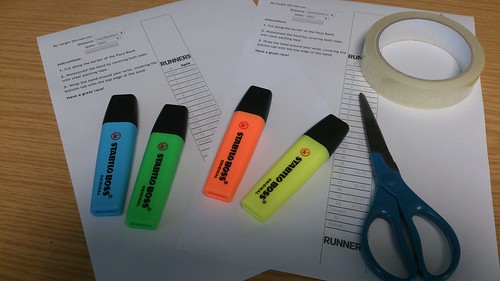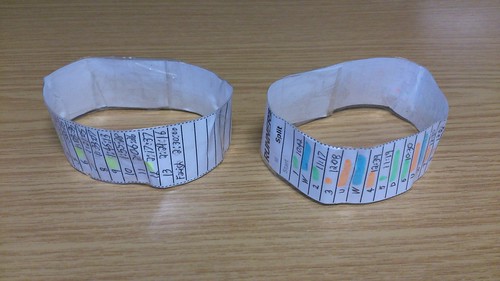All it needed was a print out of the required pacing, some multi colour pens, scissors (required adult supervision) and the obligatorily sticky back plastic. I was getting flash backs to watching Blue Peter as a child.
In Blue Peter style here is all the required items that you need to make the pace bands.

After a bit of cutting and taping, here is two pace bands that I made earlier.

You can tell I work with data and reports as each band has a different representation of the same pacing data.
The left band has cumulative total based on the varying splits based on effort (extrapolated from one of the lead pacers previous BHM race times) with a couple of checkpoints highlighted.
The right band has at least three pieces of information per mile. These are the split time for that mile, uphill or downhill (identified by colour and letter) and how steep (based on spark line length). There is also approximate location of the water stations and any significant parts of the course such and the "big dipper" and a tunnel with a sharp 90 degree turn in to an incline.
Strangely the pacing band prints the times out in a small font in grey, so I had to use a black pen and write the times over the top and slightly bigger to make it hopefully easier read when running without require to stop to check.
Along with these I will have a GPS watch (for approximate values) due to hills and tree coverage on the course and another stopwatch, so I should have enough information. The main data will be the mile markers and the time at each which as correctly measured as may not be running on the measured (sometimes marked with a blue line) route.
Due to the course there is no consecutive miles at similar pace, as we keeping the same effort that should not change much but the pace should change by about +/- 1:30 per mile. That means there will be about 14 different pace changes on the course!!!
If it was a flat course I would get the pace in the first mile and that would be it for the race, along with this being not my natural pace this is going to be a bit more challenging.
Although I have paced the Dublin marathon a couple of times with the last having a giant pink weather ballon between the pacing group!!!
All that is required on the day is to the move right foot then left foot repeating about 12,000 times and following the instructions and should meet the target chip based time.